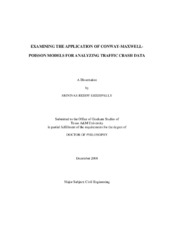| dc.contributor.advisor | Lord, Dominique | |
| dc.creator | Geedipally, Srinivas Reddy | |
| dc.date.accessioned | 2010-01-15T00:03:47Z | |
| dc.date.accessioned | 2010-01-16T00:27:31Z | |
| dc.date.available | 2010-01-15T00:03:47Z | |
| dc.date.available | 2010-01-16T00:27:31Z | |
| dc.date.created | 2008-12 | |
| dc.date.issued | 2009-05-15 | |
| dc.identifier.uri | https://hdl.handle.net/1969.1/ETD-TAMU-2333 | |
| dc.description.abstract | Statistical models have been very popular for estimating the performance of highway
safety improvement programs which are intended to reduce motor vehicle crashes. The
traditional Poisson and Poisson-gamma (negative binomial) models are the most popular
probabilistic models used by transportation safety analysts for analyzing traffic crash
data. The Poisson-gamma model is usually preferred over traditional Poisson model
since crash data usually exhibit over-dispersion. Although the Poisson-gamma model is
popular in traffic safety analysis, this model has limitations particularly when crash data
are characterized by small sample size and low sample mean values. Also, researchers
have found that the Poisson-gamma model has difficulties in handling under-dispersed
crash data. The primary objective of this research is to evaluate the performance of the
Conway-Maxwell-Poisson (COM-Poisson) model for various situations and to examine
its application for analyzing traffic crash datasets exhibiting over- and under-dispersion.
This study makes use of various simulated and observed crash datasets for accomplishing
the objectives of this research.
Using a simulation study, it was found that the COM-Poisson model can handle under-,
equi- and over-dispersed datasets with different mean values, although the credible
intervals are found to be wider for low sample mean values. The computational burden of
its implementation is also not prohibitive. Using intersection crash data collected in
Toronto and segment crash data collected in Texas, the results show that COM-Poisson
models perform as well as Poisson-gamma models in terms of goodness-of-fit statistics and predictive performance. With the use of crash data collected at railway-highway
crossings in South Korea, several COM-Poisson models were estimated and it was found
that the COM-Poisson model can handle crash data when the modeling output shows
signs of under-dispersion. The results also show that the COM-Poisson model provides
better statistical performance than the gamma probability and traditional Poisson models.
Furthermore, it was found that the COM-Poisson model has limitations similar to that of
the Poisson-gamma model when handling data with low sample mean and small sample
size. Despite its limitations for low sample mean values for over-dispersed datasets, the
COM-Poisson is still a flexible method for analyzing crash data. | en |
| dc.format.medium | electronic | en |
| dc.format.mimetype | application/pdf | |
| dc.language.iso | en_US | |
| dc.subject | Conway-Maxwell-Poisson | en |
| dc.subject | traffic crashes | en |
| dc.subject | statistical models | en |
| dc.title | Examining the application of conway-maxwell-poisson models for analyzing traffic crash data | en |
| dc.type | Book | en |
| dc.type | Thesis | en |
| thesis.degree.department | Civil Engineering | en |
| thesis.degree.discipline | Civil Engineering | en |
| thesis.degree.grantor | Texas A&M University | en |
| thesis.degree.name | Doctor of Philosophy | en |
| thesis.degree.level | Doctoral | en |
| dc.contributor.committeeMember | Guikema, Seth | |
| dc.contributor.committeeMember | Hart, Jeff | |
| dc.contributor.committeeMember | Sinha, Samiran | |
| dc.type.genre | Electronic Dissertation | en |
| dc.type.material | text | en |
| dc.format.digitalOrigin | born digital | en |


